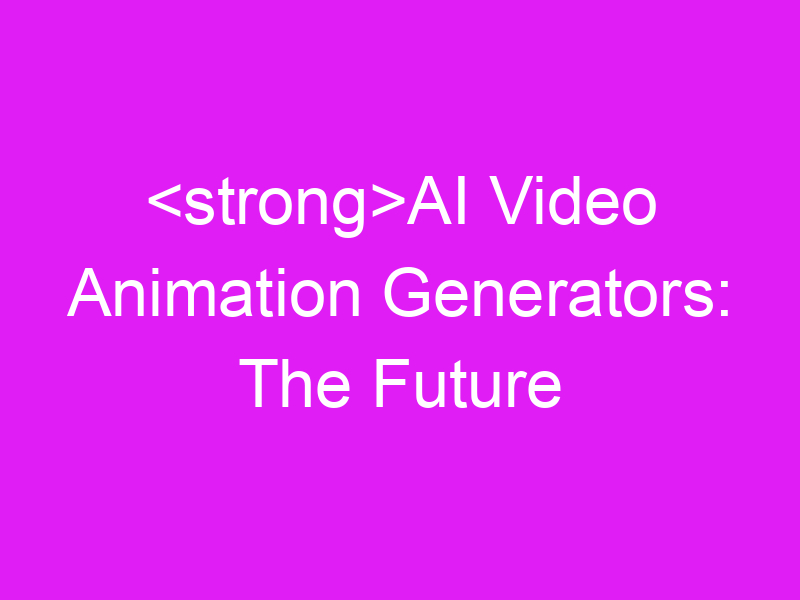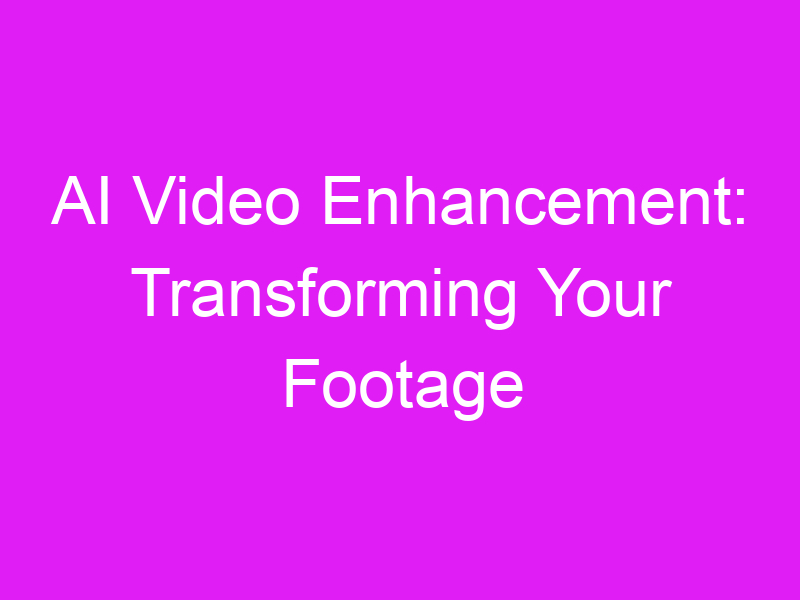Imagine transforming written words into captivating videos effortlessly. This is the power of convert text to video with ai, a revolutionary technology reshaping content creation. This comprehensive guide will explore the intricacies of this process, explaining how it works, its benefits, limitations, and the various tools available. We’ll cover everything from choosing the right AI platform to understanding the technical aspects involved, making this a valuable resource for both beginners and experienced users. Get ready to unlock a new world of video content creation!
AI-powered text-to-video conversion uses artificial intelligence algorithms to automatically generate videos from text input. This involves several complex steps, including natural language processing (NLP) to understand the text’s meaning, scene generation based on the narrative, and the synthesis of visuals and audio. Think of it as a sophisticated storytelling machine, transforming your words into engaging
visuals.
Table of Contents
ToggleNatural Language Processing (NLP) and its Role
NLP is the cornerstone of this technology. It’s the process of enabling computers to understand, interpret, and manipulate human language. In text-to-video conversion, NLP analyzes the text, identifies key entities, relationships, and sentiments to create a coherent storyline for the video.
Why Use AI for Text-to-Video Conversion?
The benefits are numerous. It significantly accelerates content creation, reducing the time and resources needed for traditional video production. This is particularly advantageous for businesses needing to create numerous short videos for social media marketing, educational materials, or internal communications. The automation aspect allows for rapid iteration and experimentation with different video styles.
Increased Efficiency and Cost Savings
Compared to traditional video production, which requires a team of professionals, expensive equipment, and significant time investment, AI-powered text-to-video tools are remarkably efficient and cost-effective. You can produce high-quality videos in a fraction of the time and cost.
Key Features of AI Text-to-Video Tools
Most advanced platforms offer various features to enhance the video’s quality and appeal. These can include customizable avatars, background music selection, voice-over generation, and even the ability to incorporate real-world footage or images into the generated video.
Customization Options for a Personalized Touch
The ability to personalize your videos is crucial. Good tools offer customization options for avatars, background music, fonts, and overall aesthetic, letting you brand your content consistently.
Choosing the Right AI Text-to-Video Platform
Several platforms offer text-to-video conversion services, each with its own strengths and weaknesses. Some focus on ease of use, while others provide more advanced features and customization options. Consider factors such as pricing, features, ease of use, and the quality of the generated videos when making your choice.
Comparing Popular AI Text-to-Video Generators
A table comparing key features of different platforms would be helpful here, including things like pricing tiers, video resolution options, customization options, and ease of use. (This would require specific research to populate with real-world examples of platforms.)
Benefits of Using AI for Video Creation
Beyond efficiency and cost savings, AI text-to-video conversion offers several other significant advantages. It makes video creation accessible to individuals and businesses lacking traditional video production expertise. It also allows for the rapid creation and iteration of video content, enabling quick response to changing market demands or trends.
Democratizing Video Content Creation
AI significantly lowers the barrier to entry for video creation, making it accessible to a broader audience. This empowers individuals and small businesses to leverage the power of video marketing without substantial investment.
Limitations of AI-Powered Text-to-Video
While AI text-to-video conversion offers many benefits, it’s not without limitations. The quality of the generated video depends heavily on the quality of the input text. Ambiguous or poorly written text can lead to incoherent or nonsensical videos. Also, the technology is still under development, and some level of human intervention may be required for optimal results. There are also current limitations on the complexity and length of videos that can be reliably generated.
Dealing with Ambiguity and Incoherence in Input Text
Clear and concise writing is crucial for good results. Tools often struggle with complex sentences, abstract ideas, or unclear instructions. Using bullet points, short sentences, and descriptive language will help.
Setting Up and Using AI Text-to-Video Software
Most AI text-to-video platforms offer user-friendly interfaces, making them relatively easy to set up and use. Generally, you’ll need to create an account, input your text, select desired options (such as avatar, background, music), and then initiate the video generation process. The process usually takes a few minutes, depending on the length and complexity of your text and the platform’s processing power.
Step-by-Step Guide to Using a Popular Platform (Example)
A detailed step-by-step tutorial using a specific platform (e.g., Synthesia, Pictory AI) would be helpful here. Screenshots of the interface would greatly enhance this section.
Advanced Techniques for Enhanced Video Output
For more sophisticated results, consider using advanced techniques. Incorporate keywords to improve SEO, use storytelling techniques in your text, and optimize your text for clarity and conciseness. Experiment with different platforms and settings to find the best combination for your needs. Always review and edit the generated video before final publication.
Optimizing Text for AI Video Generation
Providing clear, concise, and well-structured text is critical. Using descriptive language, active voice, and a clear narrative structure will help ensure a high-quality video output.
The Future of AI Text-to-Video Technology
The field of AI text-to-video is rapidly evolving. We can expect to see continued improvements in video quality, increased customization options, and more sophisticated capabilities in the near future. The technology is likely to become even more accessible and affordable, further expanding its applications across various industries.
Predicting Future Developments and Trends
Discuss potential advancements like improved realism, emotional intelligence in generated characters, and broader integration with other AI technologies.
Ethical Considerations in AI Video Generation
The widespread availability of AI text-to-video technology raises ethical considerations. The potential for misuse, such as creating deepfakes or spreading misinformation, needs careful attention. Ethical guidelines and responsible use of the technology are crucial to mitigate these risks.
Addressing Potential Misuse and Ethical Concerns
Discuss the importance of transparency, responsible use, and the development of safeguards to prevent malicious applications of this technology.
Legal Implications of AI-Generated Videos
The legal landscape surrounding AI-generated videos is still developing. Questions of copyright ownership, liability for inaccurate information, and the use of AI-generated content in advertising require careful consideration. Staying informed about evolving legal frameworks is crucial for users and developers alike.
Copyright and Ownership Issues
Discuss the complexities of copyright when using AI-generated videos, particularly regarding the ownership of the generated content and the source materials used in the process.
Integrating AI Video with Existing Marketing Strategies
AI text-to-video technology can be a powerful addition to existing marketing strategies. It can be used to create engaging social media content, explainer videos, product demos, and educational materials. Its efficiency allows for increased frequency of content releases, leading to more engagement and brand awareness.
Case Studies of Successful Implementations
Provide examples of how businesses have successfully integrated AI text-to-video into their marketing strategies.
Overcoming Common Challenges in AI Video Creation
Users may encounter various challenges, such as generating high-quality video from complex or ambiguous text, choosing the right platform, or managing costs. Understanding these challenges and implementing appropriate strategies can help overcome these hurdles and ensure a successful outcome.
Troubleshooting Common Issues and Errors
Provide practical solutions to common problems encountered when using AI text-to-video tools.
The Role of AI in the Future of Video Content
AI is set to play an increasingly significant role in the future of video content creation and consumption. Its ability to automate many aspects of the process will free up creators to focus on more creative aspects of storytelling and content strategy. It will also lead to more diverse and accessible video content across various platforms.
Predicting the Impact of AI on Video Production
Discuss the long-term consequences of integrating AI into video creation, considering potential societal shifts and economic impacts.
Frequently Asked Questions
What is convert text to video with ai used for?
AI text-to-video conversion has a wide range of applications, from marketing and advertising (creating explainer videos, social media content, product demos) to education (producing interactive learning modules) and internal communications (generating training videos or company updates). It’s also useful for creating personalized video messages, animations, and even short films.
How much does it cost to use these AI tools?
Pricing models vary widely. Some offer free plans with limitations, while others operate on subscription models with different tiers based on usage and features. Expect costs to range from free to hundreds of dollars per month depending on the platform and your needs.
What are the best practices for writing effective text for AI video generation?
Use clear, concise language, active voice, and a well-defined narrative structure. Avoid ambiguity, jargon, and overly complex sentences. Break up large chunks of text with headings and bullet points. Think of it like writing a compelling script for a video.
How long does it take to generate a video from text?
Generation time depends on the length and complexity of the text, the platform used, and its processing power. Short videos might be ready in minutes, while longer videos could take hours.
Can I use my own voice-overs or music in the generated videos?
Some platforms allow you to upload your own audio files, giving you complete control over the voice-over and background music. Others provide a library of pre-recorded voices and music tracks.
What kind of hardware/software do I need to use AI text-to-video tools?
Most platforms are accessible via web browsers, requiring minimal hardware. A reliable internet connection is crucial. Some advanced features or high-resolution video output might require more powerful hardware.
Are there any limitations on the length of videos I can create?
Yes, most platforms have limits on video length, especially on free plans. Longer videos typically require higher-tier subscriptions or might need to be broken down into shorter segments.
What about copyright and intellectual property concerns?
Using AI to generate videos may raise copyright issues depending on the source materials (images, music, voice-overs) you use. Always ensure you have the right to use any material incorporated into your AI-generated videos. Check each platform’s terms of service for specific guidance.
Final Thoughts
AI text-to-video conversion is transforming content creation, making video accessible to everyone. Its efficiency, cost-effectiveness, and accessibility are revolutionizing how we produce video content. While challenges and ethical considerations exist, the potential benefits are undeniable. By understanding the technology, its limitations, and best practices, you can unlock the power of AI to create engaging, high-quality videos that effectively communicate your message. Explore different platforms, experiment with different techniques, and start creating your own compelling AI-powered videos today. Remember to always prioritize ethical considerations and legal compliance in your video creation journey. Start experimenting and discover the potential of this innovative technology!








